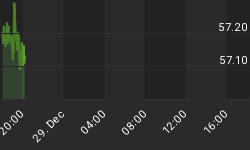In which currency are your assets denominated?
The answer to the above question is: whatever currency you like. An asset is what it is, and its value can be measured in terms of any currency or any other asset. For convenience and possibly for tax-related reasons, someone who lives in the US is likely to express asset values in terms of US dollars and someone who lives in France is likely to express asset values in terms of euros; however, the US-based person could choose to calculate in euros and the France-based person could choose to calculate in US dollars. The point is that the currency in which a person chooses to denominate their assets is solely a function of how the person does their accounting. The assets themselves are not inherently denominated in any particular currency.
We'll further explain using the examples of gold and gold mining companies.
Regardless of what currency you use to purchase gold bullion, after you have made the purchase you own ounces of gold. You don't own ounces of US$-denominated gold or euro-denominated gold. Gold is gold. You can then choose to measure the performance of your gold in terms of dollars or euros or Yen or barrels of oil or bushels of wheat or the S&P500 Index or something else entirely. The choice is yours, and the choice won't alter the fact that what you own is a certain quantity of gold ounces.
By the same token, the fact that you use Canadian dollars to purchase the shares of a gold-producing company on the Canadian stock market doesn't mean that you end up with a C$-denominated asset. What you actually end up with is ownership of a certain percentage of an asset that contains in-ground gold and that produces gold. You just happened to part with Canadian dollars in order to obtain your stake in the asset.
Currencies have experienced wide swings over the past few years, both relative to each other and relative to assets, and more wide swings are likely over the next few years. There is also a significant risk that all the major currencies will suffer massive declines in purchasing power within the current decade, making it increasingly difficult to measure how you are really doing. Are you actually making progress, or is the progress an illusion created by the debasing of the currency you happen to be using in your calculations?
Unfortunately, there is no ideal way to quantify the real (inflation-adjusted) return on your investments. Gold tends to maintain its purchasing power over the very long-term and is thus the ultimate 'accounting yardstick' when dealing in periods of several decades or more, but under the current monetary system gold's purchasing power tends to vary a lot over the course of a single decade. For example, there was a dramatic increase in gold's purchasing power during the 1970s, a relentless decline in its purchasing power during the 80s and 90s, and a substantial rise in its purchasing power during the first decade of the new Millennium. If gold's purchasing power continues to rise over the years ahead then measuring performance in gold terms will yield an unrealistically poor result, while measuring performance in terms of any fiat currency will likely yield an unrealistically good result for the opposite reason.
One possible solution would be to apply common sense. Although there are no available statistics that reliably quantify the change in a currency's purchasing power, a rational and observant person should be able to come up with a reasonable 'gut feel' assessment for how quickly the currency (or currencies) they use is (or are) losing purchasing power. This 'gut feel' assessment could then be used to quantify real progress.
Another possible solution would be to assume that the annual rate of decline in any currency's purchasing power averages out, over the course of a decade, to be roughly equal to its annual monetary inflation rate minus an allowance for productivity growth. For example, the total increase in the supply of US dollars over the past 10 years equates to an annual compound rate of about 9%, so if we assume that there was an average of 2%/year productivity growth during this period then we end up with a 7%/year estimate of purchasing power loss. This may be a little on the high side, but it's probably not far from reality.
We aren't offering a free trial subscription at this time, but free samples of our work (excerpts from our regular commentaries) can be viewed at: http://www.speculative-investor.com/new/freesamples.html
















